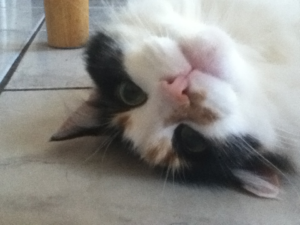I absolutely love What Is My Cat Thinking?: The Essential Guide to Understanding Pet Behavior
, by Gwen Bailey. As the mother of (currently) six cats (and countless cats in the past and future), I can tell you this: Gwen Bailey knows her kitties!
The photography in this wonderful book is gorgeous and the information is priceless. There’s a great deal of humor because, face it, cat’s are – by nature – hilarious little creatures.
Even if you’re as close to and familiar with cats as I am, I guarantee you’ll learn something from this book. It’s chock-full of fascinating insight and explanations for many of the mysteries surrounding the way our cats think and behave. While they revel in being mysterious and quirky, Gwen Bailey lets us in on a few of their secret thoughts and feelings.
It’s just an outstanding book that I turn to again and again.
Below are a few of the excellent and informative Did You Know’s from the pages of What Is My Cat Thinking?
- A cat that has been to the vet may come back smelling very different and may be treated like a stranger by other cats that once lived in harmony with him. Separating them and swapping their scents with a cloth may help.
- Adult cats are more likely to adjust to a new kitten than to a new adult cat that is introduced into the household.
- By sniffing a male cat’s urine, female cats can tell whether or not he is a suitable mate. They are able to detect by-products of his food, which tell them how much fresh meat he has eaten, and hence, how good a hunter he is. This helps determine how suitable he would be as a father for her kittens (Ming Li, apparently never found a scent she didn’t approve of!).
- The amount of socialization a kitten has with people while he is between two and seven weeks old will determine how well he will interact with people later in life. Good experiences in early life will produce a friendly, outgoing cat.
The last Did You Know is one that I certainly can attest to. The friendliest, most outgoing cats we’ve ever had were ones that we had from very, very early on. Alexa and Bo, for example, were born to our beloved Carly – we were there when they were born and every day thereafter. This produced very friendly, outgoing, and spoiled babies!
We got our precious Prissy when she was only about 6 or 7 weeks old. She was babied and pampered from the time she was tiny enough to fit in one hand to the day, over 20 years later, when we lost her. On each of those many, many, many days, Prissy was one of the sweetest, friendliest, most sociable cats I’ve ever loved. She’d greet strangers at the door, sit in any available lap and insist on being in the middle of everything.
Needless to say, I still miss that little girl something fierce but feel incredibly blessed to have had her in our family for so long.
I’m also incredibly blessed to have the beautiful little babies we have now. Alexa and Hannah are extremely outgoing and friendly. Alexa is my constant companion – always within reach for chin scratching, head rubbing, and belly tickling (and what a belly it is!).
Jelly Bean – although he was born to our feral cat Ming Li – is coming around. I can pet him easily now. I don’t push things and always allow him to call the shots. He’s a large beautiful, solid black cat with gorgeous big green eyes. He feels like absolute silk and the fact that he allows me to rub him now just makes me smile head to toe.
Tristan, Gabriel, Bullet, and Scratch (also Ming Li’s) weren’t around us at all in the first month of their lives. Ming Li brought them into our yard (and garage!) when they were past 7 weeks old. They remain very much feral cats but I honestly believe I’m winning one of them (Scratch) over. Tristan, the only girl, is a very tiny black cat and I don’t think I have any hope of ever petting her.
Bullet shows promise, but not quite as much as Scratch. Feral cats are so frustrating to people who love cats as much as I do!
Jelly Bean honestly is a reformed feral cat – he sticks close to the house and is becoming downright sociable. I have a large basket with a blue baby blanket in it for him on a shelf on our carport. It’s his bed of choice and he can be found in it 85 percent of the time. He even lets me pet him and baby talk him in his bed, something I wouldn’t have ever thought possible a few months ago.
Click the link to learn more about What Is My Cat Thinking?: The Essential Guide to Understanding Pet Behavior, by Gwen Bailey and to order a copy for you and your cat(s)!





